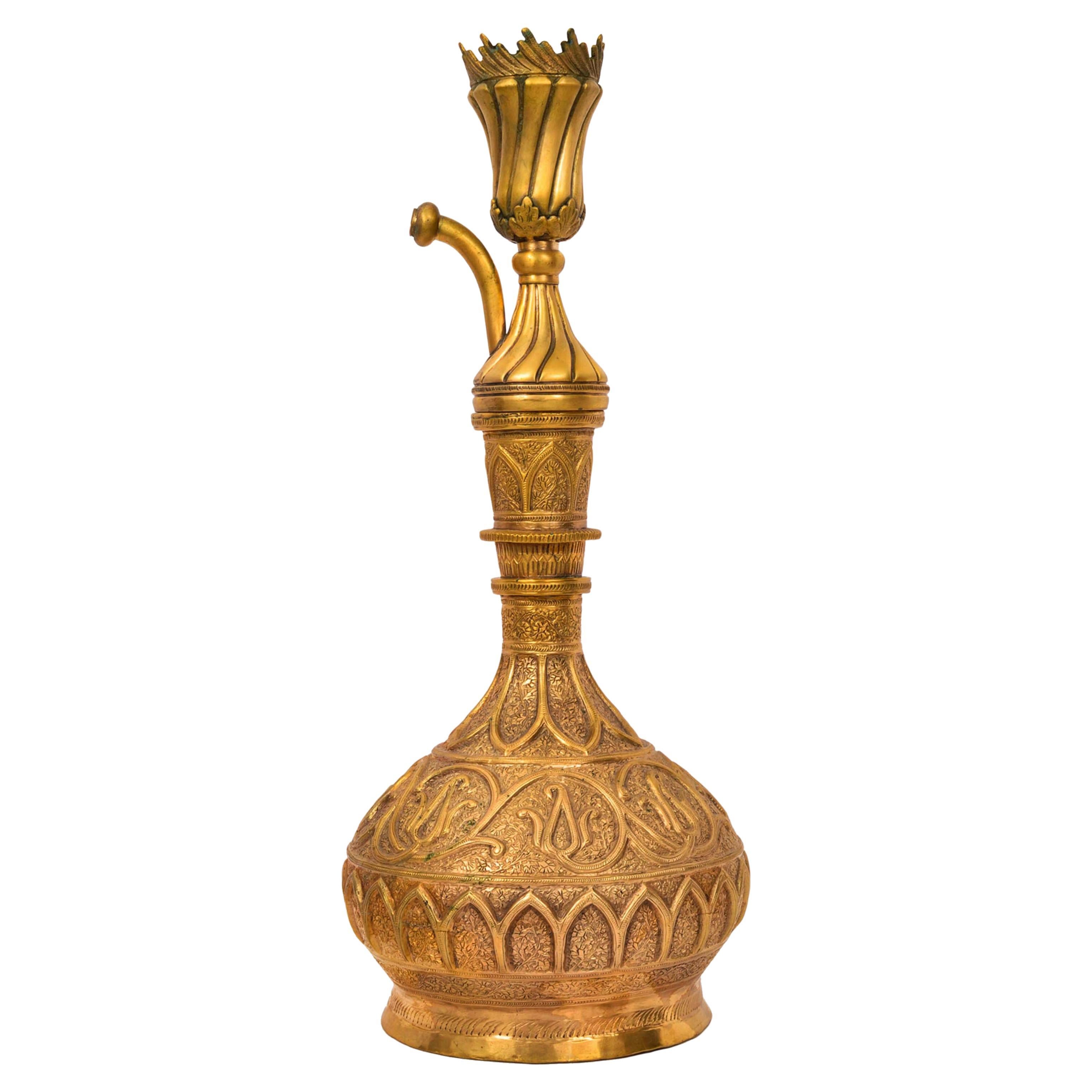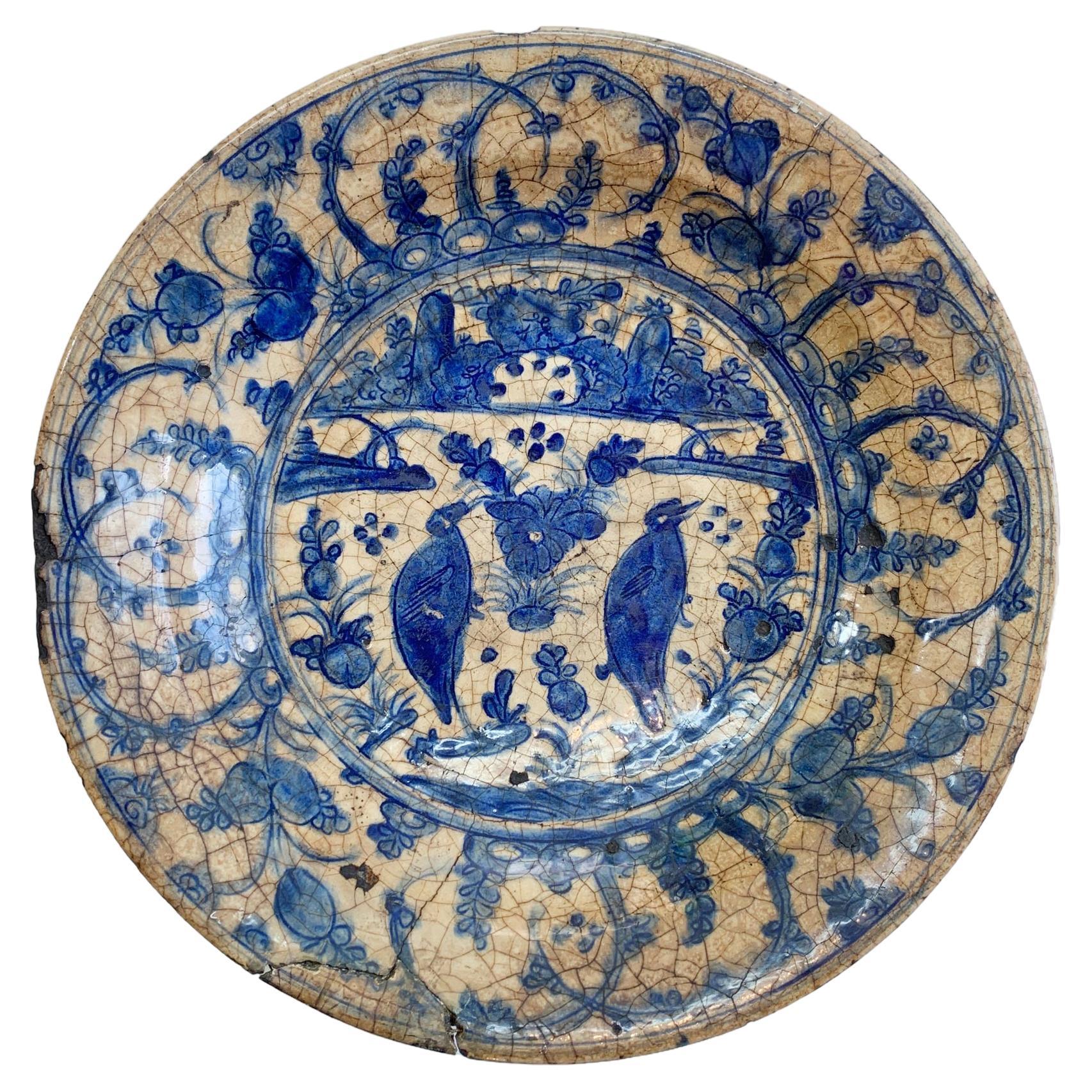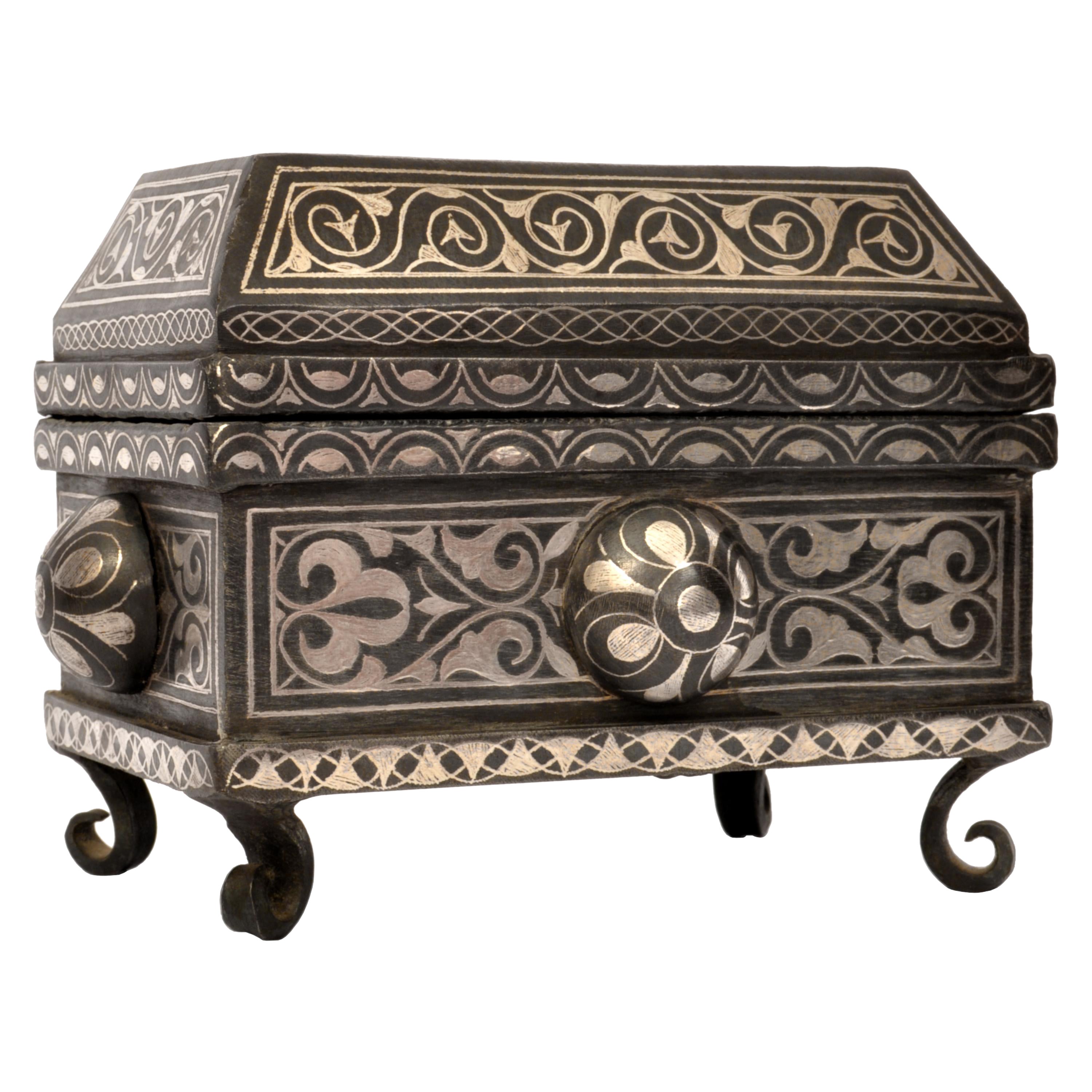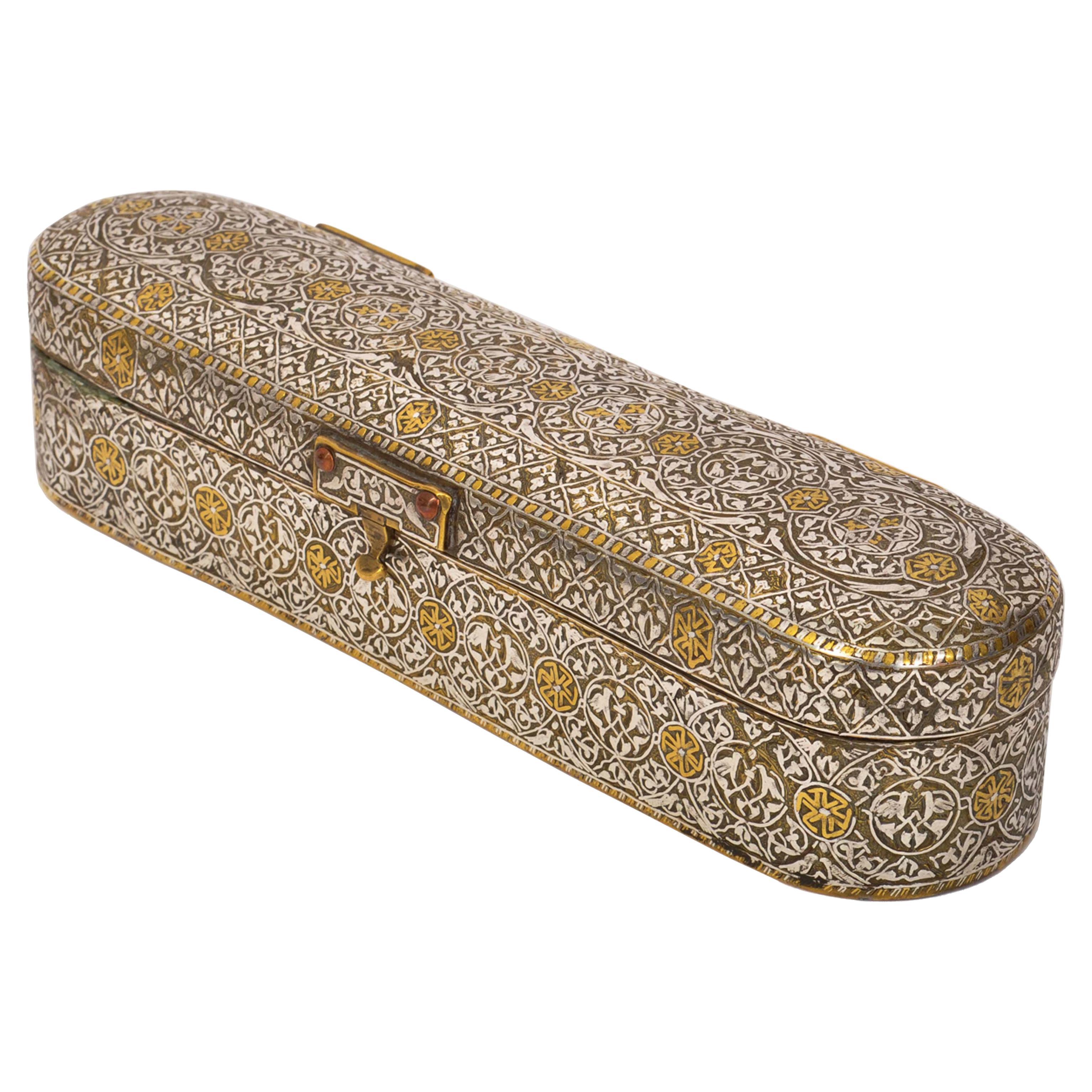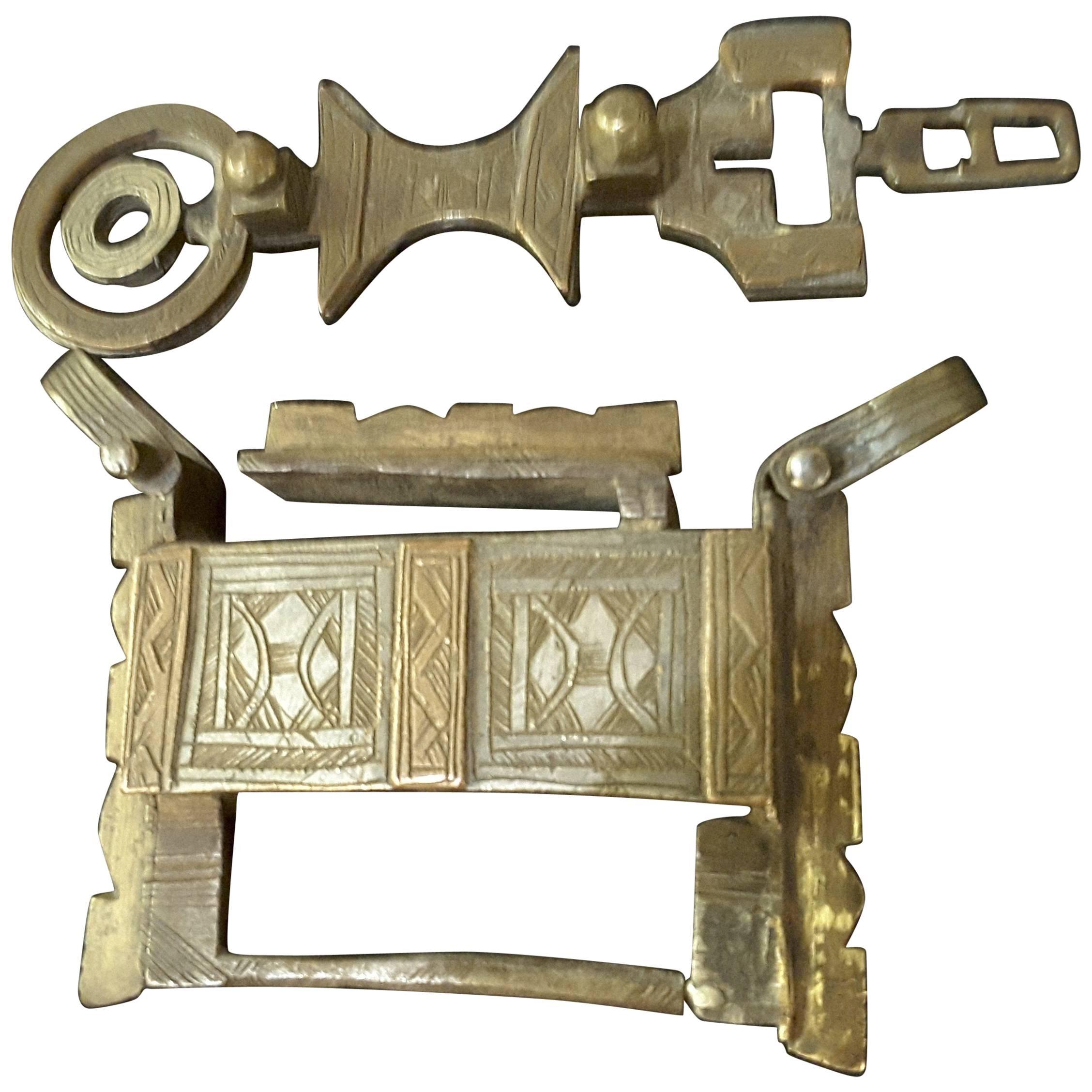Items Similar to Antique 16th Century Islamic Safavid Al Jazari Combination Locking Brass Casket
Want more images or videos?
Request additional images or videos from the seller
1 of 17
Antique 16th Century Islamic Safavid Al Jazari Combination Locking Brass Casket
About the Item
A highly important engraved Islamic combination locking brass casket, based on a design by the 12th Century Arab inventor & artist Ismail Al Jazari. Circa 1550.
The casket from the mid 16th century (or possibly earlier) Safavid period & having a hinged lid with riveted strapwork. There are four dials on the top of the lid and they are repeated on each of the four sides, each dial having circular engraved bands with Arabic letters, the casket is decorated with engraved floral Arabesque and has bands of engraved Arabic calligraphy to the top and the base, the casket is rasied on four compressed bun feet.
The casket is based on a design from Al Jazari's "Book of Knowledge", there are only five such caskets known from the 13th Century, one is shown in the Khalili Collection. This casket most likley dates to the middle of the 16th century and is unusual in that the dials are repeated on each side, not just the lid.
Condition is very good. Provenance; Property of a gentleman from a prominent Kuwaiti collection.
- Dimensions:Height: 11.875 in (30.17 cm)Width: 15.625 in (39.69 cm)Depth: 11.375 in (28.9 cm)
- Style:Islamic (Of the Period)
- Materials and Techniques:Brass,Engraved
- Place of Origin:Iraq
- Period:
- Date of Manufacture:circa 1550
- Condition:Wear consistent with age and use. The casket is in remarkable for it's age.
- Seller Location:Portland, OR
- Reference Number:
About the Seller
5.0
Platinum Seller
These expertly vetted sellers are 1stDibs' most experienced sellers and are rated highest by our customers.
Established in 2000
1stDibs seller since 2019
263 sales on 1stDibs
Typical response time: 2 hours
- ShippingRetrieving quote...Ships From: Portland, OR
- Return PolicyA return for this item may be initiated within 7 days of delivery.
More From This SellerView All
- Antique 19th Century Ottoman Islamic Tombak Gilt Copper Nargile Hookah TurkeyLocated in Portland, ORA fine & rare antique 19th Century Ottoman Tombak (Gilt Copper) Nargile or Hookah pipe, Turkey, circa 1850. A nagile or hookah pipe's history dates back...Category
Antique 1860s Turkish Islamic Tobacco Accessories
MaterialsCopper
- Antique 19th Century Indian Bidriware Pandan Silver & Brass Casket Jewelry BoxLocated in Portland, ORAntique early 19th century Indian Bidriware silver and brass Pandan casket, Circa 1800. Bidriware is credited to the Bahamani Sultans who were the rulers of Bidar in the Northeast part of the state of Karnataka, India in the 14th & 15th centuries, the artform has its roots in ancient Persia and was thought to be brought to India by the 13th century Sufi mystic Mu'in al-Din Chishti. A pandan box...Category
Antique Early 1800s Indian Islamic Metalwork
MaterialsSilver, Brass
- Antique Islamic 15th Century Mamluk Qalamdan Gold Silver Inlaid Brass Pen BoxLocated in Portland, ORA fine and important late 15th century Mamluk period inlaid penbox (Qalamdan), possibly Syria or Mosul, late 1400's. The slightly domed penbox is lavishly inlaid with gold and silver...Category
Antique 15th Century and Earlier Syrian Islamic Metalwork
MaterialsGold, Silver, Brass
- Ancient Antique 16th Century Islamic Calligraphy Mamluk Glass Mosque Lamp 1500Located in Portland, ORA rare and ancient Mamluk period Islamic handblown glass mosque lamp, Egypt or Syria, early 1500's. The lamp of diminutive form & having a flared neck with Islamic calligraphy, the g...Category
Antique 16th Century Egyptian Islamic Antiquities
MaterialsGlass
- Antique Dutch Colonial VOC Batavian Tortoise Shell Silver Sirih Casket 1750Located in Portland, ORA rare, Dutch Colonial, Batavian (now Jakarta) Dutch East Indies silver and tortoise shell Sirih casket, circa 1750. The casket was used for storing highly prized betel nut, which was chewed ritually by high ranking Indonesian officials and adopted by settlers from the Dutch East Indies Company...Category
Antique 1750s Indonesian Dutch Colonial Metalwork
MaterialsSilver
- Monumental Antique Islamic Ottoman Safavid Astrological Astrolabe on Stand 1720Located in Portland, ORAn incredibly rare 18th Century monumental palace size Ottoman Islamic astrolabe on an easel stand, Turkey, circa 1720. This rare palace size Astrola...Category
Antique Early 18th Century Turkish Islamic Scholar's Objects
MaterialsBrass, Steel, Gold Leaf
You May Also Like
- Large Himalayan Inlaid Bronze Vajra with Wrathful Faces, 15th-16th CenturyLocated in Austin, TXA large and unusual Himalayan bronze and mixed metal nine prong vajra featuring wrathful faces. In the style of the Tangut (Western Xia) Kingdom (1038 to 1227), but probably later, most likely 15th-16th century. The body of the vajra crafted from a copper alloy, with five wrathful faces on either side and gold and silver inlays to the center. The prongs crafted of iron, with each side having eight prongs arcing outwards around a central prong before coming back to a copper alloy point. The vajra is meditational tool...Category
Antique 16th Century Mongolian Metalwork
MaterialsGold, Silver, Bronze, Iron
- 16th Century Safavid Pottery DishLocated in Hastings, GBProbably Kirman, 16th/17th Century, Persia. Of Low rounded profile, on short a foot and with sloping rim, this Kirman blue and white dish with white slip decoration and stylized dens...Category
Antique 16th Century Persian Islamic Ceramics
MaterialsCeramic, Pottery
- Silver and Bronze Camel Chest Lock 19th Century, North AfricaLocated in Ottawa, OntarioA silver and bronze camel chest lock 19th century, North Africa, bought in Tunisia in the early 1960s directly from Nomads. The lock was used to lock valuables in chests which were then packed on camel caravans...Category
Antique Early 19th Century Tunisian Other Historical Memorabilia
MaterialsSilver, Bronze
- Antique Moorish Islamic Brass Bowl with Calligraphy WritingLocated in North Hollywood, CAAntique Moorish brass Middle Eastern Islamic bowl finely and heavily hand-etched with brass repousse and decorated with Arabic inscriptions. 19th century Islamic hand-etched Moorish style brass bowl. Engraved and hand-chased Arabic Islamic calligraphy and geometric arabesque, floral, designs on brass vessel. Fine antique brass decorative Islamic art object. Measures: Top opening 4" Base 5" Widest part diameter 9" Height 8". This antique Islamic brass bowl...Category
Antique 19th Century Asian Islamic Metalwork
MaterialsBrass
- Antique 19th Century Brass Islamic Middle Eastern Floor LampLocated in North Hollywood, CAExtremely fine antique Islamic floor brass lamp with Kufic Mamluke revival pierced foliate openwork’s chased and chiselled with arabic calligraphy and figures. Antique 19th century Middle Eastern Egyptian floor decorative candle lamp, Rising from wide trumpet foot through to slightly tapering cylindrical shaft with two pronounced collars to gently flaring mouth and flat rim, the shaft with pierced openwork lattice containing scrolling vine issuing from cusped palmettes, bordered above and below by bands of engraved scrolling floral vine, the upper section of the foot and the body below the mouth with further pierced openwork sections in rectangular cusped cartouches with similar design set in a ground of engraved scrolling floral vine, interlocking palmettes and stylized cloud bands, band of verses. This large floor Moorish Syrian Middle Eastern...Category
Antique Late 19th Century Egyptian Moorish Metalwork
MaterialsBrass
- Antique Islamic Brass Bowl Fine Metalwork Hand Etched BowlLocated in North Hollywood, CAAntique Middle Eastern Islamic art Moorish brass bowl engraved with Thuluth Arabic calligraphy.The polished brass bowl is profusely chased with vines and vegetal motifs and inscribed with Islamic verses of the Holly Koran.This bowl has been professionally cleaned and polished.Measures: Diameter 7.25" x 4" height Mouth opening: 5".Great Middle Eastern brass metalwork decorative Islamic art objects.Handcrafted Moorish hand-etched Islamic metal brass bowl.Engraved, incised and hammered with very fine Arabic Islamic calligraphy writing and geometric designs on brass vessel.Very Intricate fine Middle eastern Moorish Islamic Art metalwork, museum quality artwork.Late 19th Century.Date of Manufacture: Circa 1880.Condition: Wear consistent with age and use. Islamic brass metalwork is an intricate and beautiful form of art that originated in the Islamic world. It encompasses a wide range of decorative objects made from brass or other metals such as copper, bronze, and silver. Brass trays, in particular, are highly regarded for their craftsmanship and intricate designs. Islamic brass metalwork has a rich history that dates back to the early Islamic period, with its roots in the metalworking traditions of ancient civilizations such as the Persians, Greeks, and Romans. However, Islamic artisans developed their own unique styles and techniques, blending elements from various cultures and creating distinctive motifs that reflected Islamic aesthetics and religious beliefs. The process of creating brass trays involves several steps, each requiring specialized skills. Here is a general overview of the traditional techniques involved: 1) Design: A skilled artist or calligrapher creates the design for the brass object. Islamic brass metalwork often incorporates intricate geometric patterns, arabesques, floral motifs, and calligraphy inspired by Quranic verses or poetry. 2) Metalworking: The object is typically made from a sheet of brass or another metal. The metal is cut into the desired shape and then hammered or pressed to create the object. Traditional techniques such as repoussé (hammering from the reverse side) or chasing (hammering on the front side) may be employed to shape the metal. 3) Engraving: The surface of the metal is often decorated with intricate engravings or etchings. Skilled artisans use chisels, gravers, or other specialized tools to create fine details and elaborate patterns. 4) Filigree and Inlay: Some brass trays feature additional decorative elements such as filigree or inlay work. Filigree involves shaping thin wires of brass into delicate patterns and soldering them onto the tray's surface. Inlay work, on the other hand, involves embedding contrasting materials such as silver or copper into the brass, creating intricate designs. 5) Surface Treatment: After the main decorative work is complete, the tray may undergo surface treatments to enhance its appearance. This can include processes like polishing, buffing, or applying various chemical patinas to create an aged or oxidized effect. While this bowl has certainly witnessed the passage of time, it remains in remarkably good condition, with only minor signs of age that add character to its appearance. The patina on the brass enhances its antique allure, making it a truly authentic and captivating collectible. Arabic Calligraphy: The Arabic writing on the bowl is a work of art in itself. The calligraphy showcases the mastery of the scribe's hand, with flowing curves and intricate details that form an elegant script. The script may include Quranic verses, blessings, or poetic verses, depending on the bowl's origin and purpose. The inscriptions are not only visually striking but also carry profound meaning, making this bowl a beautiful representation of Islamic heritage. Intricate Patterns: In addition to the Arabic calligraphy, the bowl features intricate geometric patterns and motifs that further enhance its visual appeal. These patterns are a hallmark of Islamic art and reflect the mathematical precision and artistic creativity that defined Islamic craftsmanship. This antique Islamic brass bowl...Category
Antique 19th Century Turkish Islamic Metalwork
MaterialsBrass
Recently Viewed
View AllMore Ways To Browse
Antique Lock
Lock Antique
Antique 16th
16th Century Antiques
Islam Furniture
16th Century And Earlier
Antique Brass Collection
Antique Islam
Antique Islamic
Islamic Antique
Arabic Antique
Book Of Knowledge
Islamic Antiques
Arabic Antique Furniture
Antique Islamic Furniture
Early Islamic
Combination Lock
Casket Century
